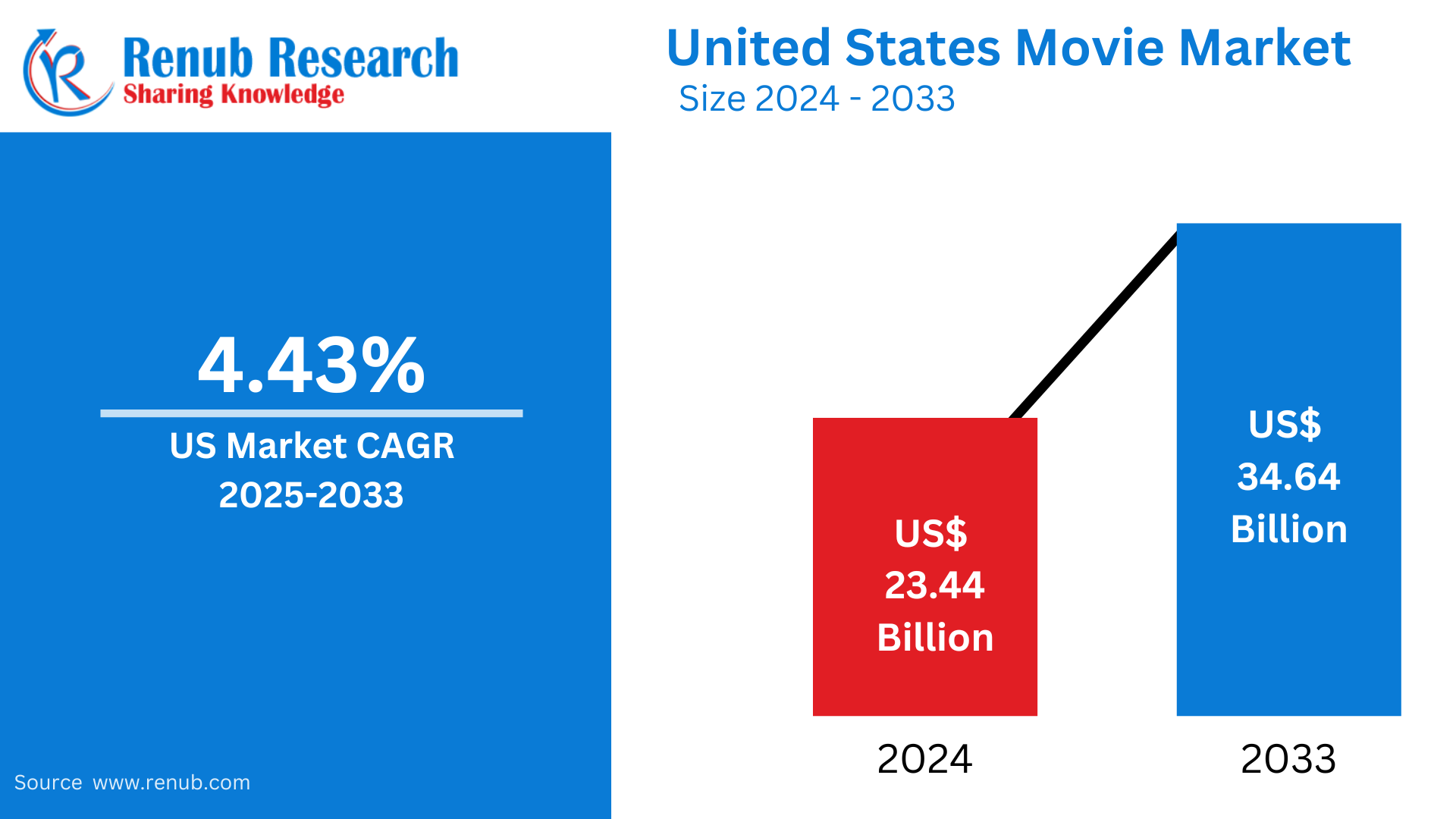United States Movie Market Analysis – Growth, Trends, and Forecast (2025-2033)
Market Overview
The United States movie market has become one of the largest and most influential segments in the global entertainment industry. Estimated to reach US$ 34.64 Billion by 2033, growing from US$ 23.44 Billion in 2024, the market is expected to expand at a CAGR of 4.43% between 2025-2033. This growth is driven by increased consumer demand for diverse and high-quality content, the continued dominance of streaming platforms, and the evolution of cinematic technologies that are revolutionizing the industry.
Movies have become integral to American culture, influencing global trends in entertainment, lifestyle, and even social and political discourse. As Hollywood continues to produce some of the highest-grossing films, advancements in digital content delivery and streaming platforms have expanded the reach and accessibility of films worldwide.
Market Drivers
- Technological Advancements in Film Production and Distribution
Technological innovations such as high-definition visual effects, computer-generated imagery (CGI), and immersive audio systems have dramatically enhanced the movie-watching experience. On the distribution side, the rise of streaming services like Netflix, Amazon Prime Video, and Disney+ has made films easily accessible to audiences worldwide. These platforms offer on-demand content, catering to the growing preference for home-based viewing.
Furthermore, new production technologies allow for high-quality visual effects, making films more appealing and engaging. For example, in August 2024, Cosmo Films announced the launch of seven new products aimed at enhancing film production and distribution at Label Expo Americas 2024, showcasing their commitment to advancing the market.
- Franchise Movies Gaining Momentum
Franchise films, particularly those based on superheroes, sequels, and expansive universes (such as the Marvel Cinematic Universe), continue to dominate the box office. These films benefit from a dedicated fan base, ensuring consistent ticket sales and merchandise revenue. Interconnected storylines across multiple films have created anticipation, leading to sustained demand. - Shift Toward Streaming Platforms
Streaming services are revolutionizing how consumers access movie content. By offering exclusive content and movies released directly on their platforms, streaming giants such as Netflix, Disney+, and Amazon Prime Video are fueling the U.S. movie market. The growing trend of cord-cutting, where viewers prefer streaming over traditional cable TV, has further contributed to the success of these platforms.
For example, in January 2024, Netflix secured an exclusive ten-year, $5 billion deal with WWE to broadcast Monday Night Raw worldwide, enhancing its content portfolio and broadening its audience base.
New Publish Reports
- United States Nicotine Pouches Market Size and Share Analysis – Growth Trends and Forecast Report 2025-2033
- United States Hospital & Nursing Home Probiotics Market Size and Share Analysis – Growth Trends and Forecast Report 2025-2033
- United States Fast Food and Quick Services Restaurants Market Size and Share Analysis – Growth Trends and Forecast Report 2025-2033
- United States Wine Cooler Market Size and Share Analysis – Growth Trends and Forecast Report 2025-2033
Challenges Facing the U.S. Movie Market
- Declining Theatre Attendance
Movie theater attendance in the U.S. has been on the decline, primarily due to the rise of streaming services and the increasing ticket prices. The COVID-19 pandemic exacerbated this trend, as audiences became accustomed to watching new releases from the comfort of their homes. As a result, traditional theaters are facing significant challenges in maintaining profitability, with many theaters having to adapt by offering premium experiences such as 3D viewing and IMAX. - Piracy and Content Leakage
Piracy remains one of the most persistent challenges to the U.S. movie industry. Online piracy and illegal streaming of films directly impact box office revenue, subscriber numbers for streaming services, and the profitability of content creators and distributors. To combat this, the industry has implemented stricter digital rights management (DRM) and taken legal action against illegal streaming sites, though piracy remains a significant concern.
Regional Analysis of the U.S. Movie Market
- California
As the epicenter of the U.S. movie market, California—particularly Hollywood—remains the leading hub for film production. The state continues to attract top talent, producers, and major studios. Streaming platforms have also established production facilities here, contributing to the state’s dominance. Iconic film festivals such as Sundance further solidify California’s global influence in the movie industry. - Arizona
Arizona’s movie market is growing steadily, bolstered by its scenic landscapes and attractive tax incentives for filmmakers. Cities like Phoenix and Tucson offer diverse filming locations, making it a popular choice for indie filmmakers. Events like the Phoenix Film Festival are helping to promote local talent and bring attention to Arizona’s growing film industry. - New York
New York offers a unique blend of urban and rural filming locations, from the iconic skyscrapers of New York City to the tranquil upstate landscapes. The state provides significant incentives for filmmakers, making it an attractive alternative to California. Major films and independent productions alike are filmed here, with events like the Tribeca Film Festival showcasing New York’s creative scene.
Market Segmentation
- Distribution Income
The U.S. movie market’s revenue is generated from several income sources:- Movie Ticket Sales
- Advertisement Income
- Sales of Food & Beverages
- Other Sources
- Screen Type
Movies are classified based on their screen type, which includes:- Digital Non-3D
- Digital 3D
- Other Types
- Gender & Age Demographics
The movie market in the U.S. caters to various demographic groups:- Male vs. Female Viewership
- Age Groups (ranging from 2-11, 12-17, 18-24, 25-39, 40-49, 50-59, and 60+)
Key Questions Answered
- What is the expected market size of the U.S. movie market by 2033? The market is expected to reach US$ 34.64 Billion by 2033.
- How has the shift towards streaming platforms influenced the U.S. movie market? Streaming platforms have fundamentally reshaped the market by providing on-demand, exclusive content and creating new distribution channels, making films more accessible to a global audience.
- What challenges does the U.S. movie industry face, especially in terms of piracy? Piracy remains a major challenge, affecting box office revenues, streaming subscriptions, and the overall profitability of the industry. Combating piracy requires stricter enforcement of intellectual property rights.
- What are the major trends in the U.S. movie market based on demographic segmentation? The market shows diverse preferences across different age groups and genders, with younger audiences (especially in the 18-24 and 25-39 age groups) showing the highest demand for streaming content.
Company Analysis
- Cinemark Holding, Inc.
- Regal Cinemas
- CGV Cinemas
- AMC Theatres
- Marcus Theatres
- B&B Theatres
- Empire Cinema
These companies represent major players in the U.S. movie theater industry, competing on factors like theater quality, customer experience, and premium viewing options.
Conclusion
The U.S. movie market continues to thrive, driven by technological advancements, the growing dominance of franchise films, and the continued expansion of streaming platforms. Despite facing challenges such as piracy and declining theater attendance, the market is expected to maintain steady growth through 2033.

